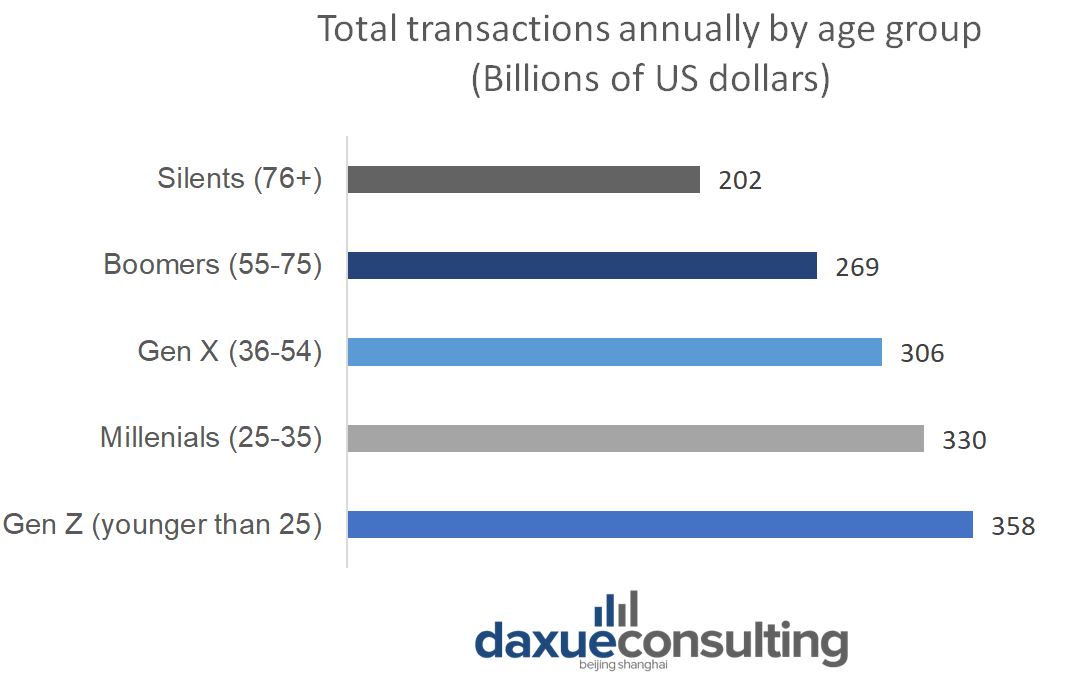Daxue consulting has launched its 7 Continents initiative to help Chinese brands reach the global market, including market research on western consumer habits. To learn more about our global strategy consulting for Chinese brands, visit our 7 Continents page.
China’s economy has expanded rapidly and its middle-class has risen during these past years, resulting in a continuous change in their way of consuming. Some foreign brands are hesitant on how to enter the market successfully, mostly because they don’t understand Chinese consumers and their shopping habits. The same goes for Chinese companies that want to develop their business globally if they don’t pay enough attention to cultural difference and understand that Western consumer doesn’t expect the same things that Chinese consumers, it may go wrong.
Consumer segmentation in the west vs. China
Despite the rapid economic rise; China’s regions have developed at different rates, making consumer trends vary between regions. But there is also a difference between tier-cities, urban-rural division, class division, and age division. Whereas Western consumer habits are more similar by region as various regions within each country are more or less equally developed.
The west’s consumption power is concentrated in older consumers
While in the West, the strongest customers are relatively old people with a stable situation and a well-paid job, which is different than China’s current gen-z lead consumption trend. According to Epsilon’s research report, in the US, baby boomers (ages 55-75 years old) spend a total of $548.1 billion annually when millennials (25-35 years old) spend $322.5 billion annually.
In China, gen Z (born between 1996-2010) is particularly powerful; it makes 15% of China’s population but makes 25% of expenditure on new brands.

Data source: MarketingCharts.com; designed by Daxue Consulting; Average spend per transaction by Generation, western consumer habits
Western Gen Z are less confident in future earnings and spend less than Chinese Gen Z, but it doesn’t mean that they are shy about spending. In fact, they make more frequent transactions than the older ones (Millenials and Gen X), spending annually $358 billion on average.

Data source: MarketingCharts.com; designed by Daxue Consulting; Average total transactions in billions of US dollar annually by Generation, western consumer habits
How shopping experiences differ from China to the West
Westerners shop less frequently than Chinese
Chinese people shop more frequently than their western counterparts, especially North Americans who tend to stock up every week or every other week. However European consumption habits lie somewhere between Chinese and North America in terms of how often they shop. In China, people are more inclined towards shopping daily for fresher products or even shopping right before cooking meals.
North American shopping habits
This difference in shopping frequency is why large mega-markets such as Wal-Mart and Costco are so popular in North America, but smaller wet-markets and convenience stores get comparatively more foot traffic in China. Both these diverse contrasting consumer habits are driven by convenience. Because in contrast to China’s walkable cities, most North Americans need to drive every day, so shopping in bulk at one hypermarket and filling a car up with a weeks’ or more worth of groceries is more convenient. But for the Chinese, getting fresh produce at a nearby market on the walk back from work is more convenient.
Euopean shopping habits
In Europe, there are many different types of grocery stores such as Lidl, Carrefour, or Aldi, which are smaller than US superstores. In European countries, different products may be found in the cities than in the country . European companies use far fewer preservatives and pesticides in their perishable’s products than Americans ones, so Europeans need to shop more often than Americans.
Those in European countryside are more likely to shop at local farmers markets than their urban counterparts. In big cities such as Paris, the farmers’ market is mostly held Wednesday or at the weekend, when affluent or old people can shop for fresher products. Most of the grocery shops and supermarkets are closed on Sunday.
Chinese enjoy shopping more than westerners
According to the research firm Millward Brown, the feeling that shopping is enjoyable rather than a chore is much stronger among Chinese than American consumers. Survey results found 68% of Chinese respondents said they were “happy” with their shopping experiences, compared with only 48% of American respondents who said they felt the same way. Chinese consumers are also more engaged than those from the U.S. for learning about products they are interested in purchasing, but this tendency is changing in the West, where people are more concerned about their consumption habits, especially after the COVID-19 outbreak.
Western consumption habits are evolving, quality and purpose (desire to support local businesses, farmers, etc.) are one of the new concerns rising. But, value-based purchasing which prioritizes obtaining maximum value for the money spent is still the more important key factor in the West where bargains are heavily sought, whereas price isn’t always the key factor in a purchase decision for Chinese buyers. Shopping in the West is more about purchasing products needed when Chinese consumers it is more likely an enjoyable customer experience who are not looking to visits a store just for buying products but to have a shopping journey that they can talk to their friends and relatives about or on social media.

Source: Dmb-Shanghai.com, Chinese expectations for the shopping experience, Alibaba Single Day’s gala
What role does customer service play in the west?
One big difference between Chinese and western consumer habits is their expectations from customer service. Chinese consumers find it important that the service they receive is tailored to their individual needs. Whereas, in the West, consumers appreciate the self-service shopping experience and contact vendors only when something is going wrong. Otherwise, they prefer the customer service staff to give them space to make decisions, and westerners may find it irritating to have staff recommend products.
This is a stark contrast to China, especially in some stores like Watsons where consumers are greeted upon entering the store, and staff gives product recommendations based on the immediate impression of the consumer profile. Through Chinese customer service can boost sales by salespeople being both assertive and aggressive in suggestions, shop assistants are friendlier in the West, they will take time to answer questions and try to settle things easier for the customers if they ask for. Another point is that there are sales festivals in China but both US and Europe have sales season, customer service may decrease at these moments.
Western e-commerce customer service is less responsive than Chinese platforms
Partly due to the prevalence of counterfeit and unsafe goods on e-commerce platforms,. Chinese consumers demand more assurances during the shopping process. Online marketplaces like Taobao or Tmall.com have implemented instant messaging services that allow Chinese consumers to connect directly to the vendors, so they can ask about any issues.
Brand loyalty in the west vs. China
The whole concept of loyalty to brands is relatively new in China, except for luxury brands which are used mostly for the status symbol, Chinese people are yet to build an affinity for one brand but they are brand conscious. This doesn’t mean that brands for everyday items are not important, it just means that Chinese consumers don’t look necessarily for any brand when they are shopping, allowing both foreign and domestic brands to cultivate stronger ties through effective marketing. When in the West, it is more common to have their favorite brands and to buy them.
One of the biggest differences between Chinese and Western consumer habits is related to online advertising, for example, Westerner consumers, especially Europeans, tend to find online advertising irritating and intrusive whereas Chinese consumers pay more attention to ads and will often welcome them well as a means of learning about new brands. For a brand, too much online advertising or a not well-targeted ad may just annoy the Western audience and lose their attention.
Sustainability and value-driven consumption in the west

Source: Wired.com; Clothes made of plastic bottles.
Western consumption habits are changing to be more value-driven. Shoppers have increasingly protested against the excessive use of plastic, but plastic consumption is not the only concern. In general, western consumers demand higher standards for sustainability, hence, there are independent organic food stores, bioproducts, and recyclable packaging.
Other #woke consumption trends are consumers paying attention to their treatment of animals and the working conditions in the supply chain. “Slow fashion” is the new trend to counter-act fast fashion. Sustainability and ethical treatment may become the global trend in the next years in the West. There is also a rise of second-hand stores and flea markets in Europe which people can save money while minimizing damage to the planet.
Comparing the digital consumer ecosystems of the west and China
The western e-commerce ecosystem relies more on brand websites
In contrast to China, where about 90% of e-commerce is done in an online marketplace. In the West, merchants have their own stand-alone shopping website, also known as brand.com, which is more attractive and common to Western shoppers who are loyal to their favorite brands.
This difference also causes brands to rely more on Google SEO when marketing in the west. Rather than directly searching for products on Amazon, many westerns will first Google about the product or brand they are interested in. One of the disadvantages of relying on brand websites is that each website has its way to function; some websites will not display too many details on products for example.
In Europe they will use a different platform for deliveries; it takes sometimes 7 days to receive online deliveries, making offline shopping smoother than online shopping. Each website has its customer service and hotline, which may be inefficient depending on each company.
Accordingly, brands advertising in the west often link their ads to their brand website rather than drive traffic to an e-commerce site.
How Chinese vs. western consumers gain trust
Chinese consumers depend heavily on product recommendations from online reviewers. They pay attention to what their peered are buying and saying on social media when they shop. 75% of Chinese internet users post online feedback on their purchases at least once a month, compared with less than 20% in the U.S. Even in the West, social media plays a huge part in engagement for a brand thanks to the influencers.
Digital adoption is much easier in the Chinese market compared to the West. According to the PwC survey, China leads the world in mobile shopping: over three out of four Chinese consumers said they have used a mobile phone to shop, compared with a global average of 43%. More significantly, one in four Chinese consumers says they shop with a mobile phone at least once a week. The global average is around 9%. But, with the outbreak of COVID-19, Western consumption habits have shifted to more online shopping.
How much of consumption in the west is through e-commerce?
Even in the West, shopping habits in North America and Europe are quite different. North Americans are much more online-focused in shopping than Europeans who still prefer to shop in a physical store. 71% of North American consumers find shopping online more convenient, compared to about half in Europe.
72% of European consumers do most of their shopping in physical stores, compared to the 52% of North Americans. North America is more geographically dispersed which is why online shopping is more convenient as it is not easy to get to a physical store. European countries are more densely populated, which makes it easier to get to a physical store rather than waiting for a delivery. Consumers in both regions want retailers to develop a stronger connection between the physical store and online channels, a method known as new-retail which is already widely used in China, to get a better shopping experience.
Digital payments are less widely used in the west compared to China. The mobile payment market in the west is highly fragmented, it’s becoming harder for customers to keep up with the number of digital wallets. Western ecosystems such as Apple Pay and Google Pay are the two major players, but they’re often not available at many major retail brands.

Source: TechArtes.com; Various online payment platform and processors in western countries
What Chinese brands should know about western consumer habits
- Western consumers shop less frequently than Chinese counterparts, making supermarkets and hypermarkets an important sales channel for a wide range of goods.
- Western consumers are also more and more concerned about ethics. It is important for a Chinese brand entering the west to be clear on their sustainability strategy transparent with their supply chain.
- Shopping habits differ by country, but within countries, there is not distinct regional patterns for consumption. Rather, age and income are more important.
- Excessive ads are not welcome and irritating most western consumers. Therefore, brands should have a precise ad targeting strategy. However, e-mail marketing is more welcome in the west, so brands can get repeat purchases through strategic (not too frequent) email campaigns.
- Providing a complete omnichannel shopping experience, connecting physical stores and online-channel is essential, though the west is not as developed as China in this front. This is where Chinese brands may have an advantage.
- Understanding the difference in culture to adapt its products, marketing strategy, and target audience.
- Western consumers are not homogeneous, and it is worth doing market research to learn more about your brand’s target consumer group.
How Daxue Consulting can help you with your global strategy:
The way consumers see their world, the motivation that drives them, and the thinking styles that affect their judgments and decisions are influenced by culture. Culture influences the values that consumers hold, the goals that they pursue, and the ways that they perceive, categorize, and reason about their environment.
In our 7 Continents consulting, we can help Chinese brands better understand western consumer habits compared to Chinese consumer groups and guide them in their global market strategy.
To learn more about global market research for Chinese companies, contact our 7 Continents consultants.
Learn something new? Stay updated on the Chinese market by following our WeChat, scan the QR code below, or subscribe to our newsletter

What do Chinese consumers consider healthy? See our survey results
Listen to over 100 China entrepreneur stories on China Paradigms, the China business podcast
Listen to China Paradigm on Apple Podcast






